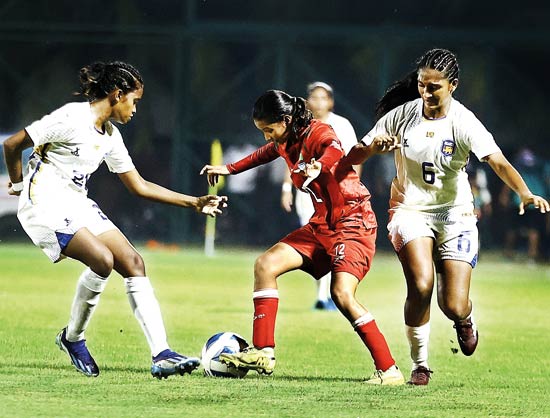Football Federation’s failings laid bare by U-20 Women’s team collapse
While the national men’s senior team—comprising mostly foreign-based professional players with Sri Lankan roots—has performed decently at global level, the national Under-20 girls’ football team appears to be heading in a different direction. Improving their status in the FIFA World Rankings, the senior men’s team has managed to climb four places, from 200 to 196, after winning three out of four international fixtures played so far this year.
However, it is a contrasting scenario when it comes to the women’s teams. Despite having few or no international assignments in recent times, the senior women’s team occupies the 159th position—one place lower in the latest FIFA World Rankings—while the junior team has indicated a chilling outlook for the island nation’s future in football.

This was clearly displayed at the SAFF U-20 Women’s Championship 2025, held from 11 to 21 July in Dhaka, Bangladesh. Competing against three other nations in the region—hosts Bangladesh, Bhutan, and Nepal—Sri Lanka finished at the bottom of the table, suffering six defeats. Out of the 71 goals scored across 12 matches in the tournament, Sri Lanka managed to score only once while conceding a staggering 38 goals—an alarming statistic. The lone goal was scored against the eventual champions, Bangladesh, who nevertheless netted nine goals in that match. In their second outing, Sri Lanka suffered a 5-0 loss to a struggling Bhutan side, followed by another heavy 7-0 defeat at the hands of Nepal.
In the second round, Nepal improved their tally further with another 7-0 win over Sri Lanka. Bangladesh recorded a 5-0 victory in Sri Lanka’s fifth fixture, and the islanders ended the tournament in fourth place with yet another 5-0 defeat, this time again to Bhutan.
These results expose the sorry state of domestic women’s football in Sri Lanka, where organised competitions have been absent for several seasons. National teams are often selected through makeshift trial processes—a lacklustre approach traditionally adopted by the football administration for many years. The system of consistently maintaining national pools has been grossly neglected, despite it being the only proven method adopted by most successful footballing nations.
The recent successes of the men’s senior team, however, mask the failures of Sri Lanka’s other national squads at global and regional levels. Marred by controversies leading up to the election of the current Football Federation of Sri Lanka administration, the country’s only source of sporting solace lies in the ever-improving standard of the men’s senior side, which has the ability to assemble and perform at short notice. This is largely due to the commitment of foreign-based professional players, who are actively engaged in the sport overseas.
The only sport in Sri Lanka where professionalism is fully embraced is, unsurprisingly, cricket. National squads are maintained according to clear guidelines, with players receiving proper remuneration. Cricket’s rise to prominence followed Sri Lanka’s historic World Cup victory in 1996, and it has since become the island’s only sport where athletes can pursue full-time professional careers—even at domestic level.
Despite being the second richest sport governing body in Sri Lanka—with substantial annual grants from FIFA and the AFC, Asia’s football governing body—football continues to languish as the so-called ‘poor man’s sport’. To add further woes to the dismal state of national teams beyond the men’s senior side, Sri Lanka appears to either lack or blatantly ignore the fundamental requirements for maintaining national squads.
How—or when—Sri Lanka will address these systemic failings remains the responsibility and burden of local football administrators. But for now, that question remains sadly unanswered.


